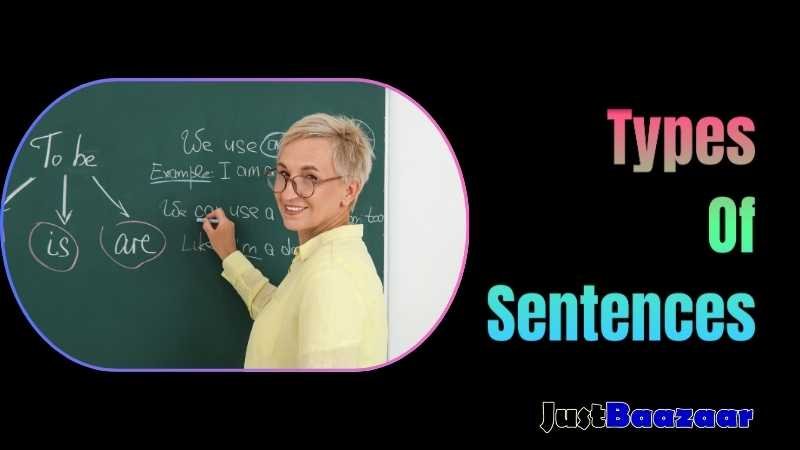Types of Sentences in English Language, Simple Sentences, Compound Sentence, Examples to Elaborate, Easy Tips and Tricks:

Learn How to Make Money Online – Get FREE Guide Worth Rs 5999– Click HERE
Chapter 1 – Introduction to Types of Sentences
In the world of language and communication, sentences play a crucial role. They are the building blocks that convey our thoughts, ideas, and emotions. Understanding the different types of sentences is essential for effective communication and clear expression. In this book, “Types of Sentences in English Language,” we will explore the two fundamental types: simple sentences and compound sentences.
The purpose of this book is to educate readers on the structure and usage of simple and compound sentences. By providing examples and practical tips throughout each chapter, we aim to equip you with the necessary tools to enhance your writing skills.
Before we dive into the specifics, let’s briefly discuss why it is important to understand different types of sentences. By mastering sentence structure, you gain greater control over your writing. You can convey meaning with precision and clarity while engaging your readers effectively.
Throughout this book, we will use examples to illustrate each concept clearly. Examples serve as a powerful learning tool because they provide tangible instances that allow us to grasp abstract ideas more easily.
Now that we have set our goals for this book let’s begin by exploring simple sentences in Chapter 2.
Chapter 2 – The Basics: Simple Sentences
Simple sentences are the foundation upon which more complex sentence structures are built. A simple sentence consists of one independent clause containing a subject and a verb that expresses a complete thought.
To better understand its components, let’s break down a simple sentence:
Subject: The subject is who or what performs an action or is being described in a sentence.
Verb: The verb shows what action is being performed by or upon the subject.
Object: The object receives the action performed by the subject.
For instance:
– “John plays basketball.” In this example, John is the subject performing an action (plays), while basketball serves as an object receiving that action.
However, not all subjects or objects need to be singular nouns. They can also be pronouns, phrases, or clauses. For example:
– “They are going to the beach.” Here, “they” acts as the subject, and “the beach” serves as the object.
It is important to note that a simple sentence can contain additional elements such as adjectives and adverbs, which provide more description and detail. These elements enhance the richness of your writing.
Now that we have grasped the fundamentals of simple sentences let’s move on to compound sentences in Chapter 3.
Chapter 3 – Expanding Ideas: Compound Sentences
While simple sentences express complete thoughts individually, compound sentences allow us to connect two or more independent clauses to create more complex ideas.
A compound sentence consists of two or more independent clauses joined by coordinating conjunctions like “and,” “but,” or “or.”
Let’s explore how this works:
– Independent Clauses: An independent clause is a group of words that expresses a complete thought and can stand alone as a sentence.
– Coordinating Conjunctions: These conjunctions are used to join two independent clauses together. They include words like “and,” “but,” and “or.”
For example:
– “I went for a walk, but it started raining.” Here, we have two independent clauses (“I went for a walk” and “it started raining”) connected by the coordinating conjunction “but.”
Compound sentences allow us to convey complex ideas with clarity and coherence. By combining multiple thoughts into one sentence, we add depth and variety to our writing.
In Chapter 4, we will delve deeper into transforming simple sentences into compound ones using examples for practice.
Chapter 4 – From Theory to Practice: Examples to Elaborate
To truly grasp the structure of compound sentences, it is crucial to practice transforming simple sentences into compound ones using coordinating conjunctions effectively.
Let’s take an example:
Simple Sentence: “She studied hard for her exam.”
Compound Sentence: “She studied hard for her exam, and she aced it.”
In this example, we transformed the simple sentence into a compound sentence by adding another independent clause (“she aced it”) joined by the coordinating conjunction “and.”
Throughout this chapter, we will provide step-by-step explanations and additional practice exercises to help you strengthen your understanding of transforming simple sentences into compound ones.
By the end of Chapter 4, you will have gained practical experience in constructing compound sentences and reinforcing your knowledge.
In Chapter 5, we will explore easy tips and tricks to master sentence variety, allowing you to enhance the readability and engagement of your writing.
Chapter 5 – Mastering Sentence Variety: Easy Tips and Tricks
Sentence variety is essential in captivating readers’ attention. By incorporating both simple and compound sentences into your writing, you create a dynamic flow that keeps readers engaged.
Here are some practical tips:
1. Vary Sentence Length: Mix shorter sentences with longer ones to create rhythm and avoid monotony. Short sentences can emphasize important points while longer sentences provide elaboration.
2. Experiment with Sentence Structure: Play around with different structures such as starting with an introductory phrase or using inverted word order. This adds variety and keeps your writing interesting.
3. Balance Complexity: Use a mix of simple and compound sentences to maintain a balance between straightforward information delivery and more complex ideas. This ensures clarity while adding depth to your writing.
4. Avoid Common Pitfalls: Watch out for sentence fragments (incomplete thoughts) or run-on sentences (multiple independent clauses without proper punctuation). These errors can hinder comprehension.
By incorporating these easy tips and tricks into your writing, you will be able to craft compelling narratives that engage readers on multiple levels.
Understanding the different types of sentences is crucial for effective communication in English language. By mastering both simple and compound sentence structures, utilizing examples effectively, practicing transformations, and employing easy tips and tricks, you can elevate your writing to new heights.
In the following chapters, we will delve deeper into each type of sentence and explore additional strategies to enhance your writing skills. Stay tuned for more insightful lessons in “Types of Sentences in English Language.”
Learn How to Make Money Online – Get FREE Guide Worth Rs 5999– Click HERE
Chapter 2 – The Basics: Simple Sentences
Introduction:
Understanding the basics of simple sentences is crucial in developing strong writing skills. In this chapter, we will delve into the definition and characteristics of simple sentences, as well as explore the placement of subjects, verbs, and objects within them. By mastering these fundamentals, you will be equipped with the necessary knowledge to construct clear and concise sentences.
Defining Simple Sentences:
A simple sentence is a complete thought that contains one independent clause. It consists of a subject, a verb, and sometimes an object. The subject is the main noun or pronoun that performs the action or experiences something in the sentence. The verb is the action or state of being performed by the subject. And finally, an object can be present to receive the action of the verb.
Placement within Simple Sentences:
In a simple sentence, it’s important to understand where each element should be placed for clarity and coherence.
Subject Placement:
The subject usually comes before the verb in a simple sentence. For example:
– Alice reads books.
– Dogs bark loudly.
– They enjoy playing soccer.
In these examples, “Alice,” “Dogs,” and “They” are all subjects placed before their respective verbs.
Verb Placement:
The verb follows directly after the subject in most cases:
– Sarah dances gracefully.
– He sings beautifully.
– We eat dinner together.
Here, “dances,” “sings,” and “eat” are verbs that immediately follow their subjects.
Object Placement:
If present in a sentence, objects usually come after both the subject and verb:
– She loves chocolate cake.
– They painted their house blue.
– We visited Paris last summer.
In these examples, “chocolate cake,” “their house,” and “Paris” are all objects placed after both their respective subjects and verbs.
Examples showcasing different Types of Subjects, Verbs, and Objects:
Subjects:
1. The diligent student studied all night.
2. My best friend and I went to the movies.
3. The cat lazily stretched on the sunny windowsill.
Verbs:
1. James runs five miles every morning.
2. The birds chirp cheerfully at dawn.
3. They laughed uncontrollably at the joke.
Objects:
1. Mary baked a delicious apple pie.
2. We bought new furniture for our living room.
3. He wrote a heartfelt letter to his parents.
Connecting Material to the Book Title:
Understanding simple sentences is vital when exploring the broader topic of types of sentences in English language usage. By mastering the basics, you lay a strong foundation for comprehending more complex sentence structures, such as compound sentences, which will be discussed in detail in Chapter 3.
Conclusion:
In this chapter, we have explored the fundamentals of simple sentences, including their definition and characteristics, as well as proper placement of subjects, verbs, and objects within them. By understanding these key elements, you can construct clear and concise sentences that effectively convey your thoughts and ideas. In the next chapter, we will expand upon this knowledge by delving into compound sentences and how they enhance sentence variety and complexity in writing.
Learn How to Make Money Online – Get FREE Guide Worth Rs 5999– Click HERE
Chapter 3: Expanding Ideas: Compound Sentences
Introduction:
In the previous chapter, we explored the basics of simple sentences and their components. Now, let’s dive into the world of compound sentences. Understanding compound sentences is crucial for effective communication and writing. In this chapter, we will explore the definition, characteristics, and usage of compound sentences. We will also learn about coordinating conjunctions and how they unite independent clauses to form compound sentences.
Definition and Characteristics of Compound Sentences:
A compound sentence consists of two or more independent clauses joined together by coordinating conjunctions or punctuation marks such as semicolons. Unlike simple sentences that express a single complete thought, compound sentences allow us to convey multiple related ideas in one sentence.
To identify a compound sentence, look for two or more independent clauses that can stand alone as separate sentences but are connected to each other.
Coordinating Conjunctions:
Coordinating conjunctions are essential in forming compound sentences. They act as bridges connecting independent clauses while indicating the relationship between them. The most common coordinating conjunctions are “and,” “but,” “or,” “so,” “for,” “nor,” and “yet.”
Let’s examine how these coordinating conjunctions work:
1. And – Adds information or combines similar ideas.
Example: She loves to dance, and he enjoys playing music.
2. But – Expresses contrast or introduces an opposing idea.
Example: He wanted to go out, but it started raining heavily.
3. Or – Presents alternatives or options.
Example: Would you like tea or coffee?
4. So – Shows cause and effect or indicates a result.
Example: She studied hard for her exams, so she scored top marks.
5. For – Provides reasons or explanations.
Example: He worked tirelessly all night, for he had a deadline to meet.
6. Nor – Connects two negative ideas in parallel structure.
Example: He neither listens to advice nor accepts criticism.
7. Yet – Expresses contrast or introduces a surprising outcome.
Example: She was tired, yet she managed to finish the marathon.
Combining Independent Clauses:
Now that we understand coordinating conjunctions, let’s explore how to combine independent clauses using them.
1. Using a comma and coordinating conjunction:
Example: I woke up early, and I went for a run in the park.
2. Using a semicolon:
Example: She loves reading; her favorite genre is mystery novels.
3. Using a semicolon and conjunctive adverb:
Example: He had studied hard; therefore, he passed the exam with flying colors.
It’s important to note that when joining independent clauses with coordinating conjunctions, it is crucial to use proper punctuation and ensure that both clauses are grammatically complete on their own.
Practice Exercises:
To reinforce our understanding of compound sentences, let’s practice transforming simple sentences into compound sentences using coordinating conjunctions:
1. Simple Sentence: The sun was shining brightly.
Compound Sentence: The sun was shining brightly, so we decided to have a picnic in the park.
2. Simple Sentence: She loves playing soccer.
Compound Sentence: She loves playing soccer, but her brother prefers basketball.
3. Simple Sentence: He wants to travel the world.
Compound Sentence: He wants to travel the world or experience different cultures firsthand.
Mastering compound sentences allows us to express complex thoughts more effectively while maintaining clarity in our writing. By combining independent clauses using coordinating conjunctions, we can create dynamic and engaging sentences that captivate readers’ attention.
Conclusion:
In this chapter, we explored compound sentences and their characteristics. We learned about coordinating conjunctions and how they connect independent clauses in compound sentences. By practicing transforming simple sentences into compound sentences using coordinating conjunctions, we enhance our ability to craft well-structured and engaging writing.
In the next chapter, we will delve into the importance of using examples to elaborate on different sentence structures effectively. We will provide step-by-step explanations and additional exercises for readers to reinforce their understanding.
Learn How to Make Money Online – Get FREE Guide Worth Rs 5999– Click HERE
Chapter 4: From Theory to Practice: Examples to Elaborate
As we delve deeper into our exploration of different types of sentences, it’s essential to bridge the gap between theory and practice. In this chapter, we will provide you with practical examples and step-by-step exercises to transform simple sentences into compound sentences using coordinating conjunctions.
Understanding sentence structures effectively is not only about grasping the concepts but also about applying them in real-life situations. By working through examples and practicing the transformation process, you will gain confidence in constructing compound sentences effortlessly.
To begin, let’s revisit the definition of a simple sentence. A simple sentence contains one independent clause and expresses a complete thought. It consists of a subject, verb, and an optional object or complement. For instance, “John runs in the park.” In this example, “John” is the subject, “runs” is the verb, and “in the park” serves as an optional prepositional phrase acting as an adverbial complement.
Now that we have established what a simple sentence entails let’s move on to transforming these simple sentences into compound sentences by introducing coordinating conjunctions. Coordinating conjunctions are words such as “and,” “but,” or “or,” which can be used to join two independent clauses.
Let’s take our previous example: “John runs in the park.” If we want to add more information or another related idea, we can transform this into a compound sentence by using a coordinating conjunction like “and.” The revised sentence would be: “John runs in the park, and he enjoys it.”
In this transformed version of our original simple sentence, we have added another independent clause with its own subject (“he”) and verb (“enjoys”). The coordinating conjunction “and” connects these two independent clauses together seamlessly.
To help you practice this transformation process further, let’s work through some sample exercises:
Exercise 1:
Transform the following simple sentence into a compound sentence using a coordinating conjunction.
Example: Sarah likes to read books. She also enjoys writing stories.
Transformation: Sarah likes to read books, and she also enjoys writing stories.
Exercise 2:
Transform the following simple sentence into a compound sentence using a coordinating conjunction.
Example: The dog barks loudly. The cat sleeps peacefully.
Transformation: The dog barks loudly, but the cat sleeps peacefully.
By practicing these exercises, you will develop a better understanding of how to use coordinating conjunctions effectively in transforming simple sentences into compound sentences. Remember, coordination allows you to express more complex ideas and create a sense of connection between different thoughts or actions within your writing.
To reinforce your understanding further, we have provided additional practice exercises at the end of this chapter. Take your time and work through them at your own pace. By doing so, you’ll gain mastery over transforming simple sentences into compound sentences effortlessly.
This chapter has focused on bridging theory with practice by providing examples and step-by-step exercises for transforming simple sentences into compound sentences using coordinating conjunctions. By actively engaging with these exercises and applying the concepts learned throughout this book, you will become proficient in constructing varied and engaging sentences in your writing.
In the next chapter, we will delve deeper into mastering sentence variety through easy tips and tricks that will enhance readability and engagement in your written work. Stay tuned as we explore techniques for varying sentence length, structure, complexity while avoiding common pitfalls when constructing different types of sentences.
Remember to practice consistently as it is through practice that mastery is achieved!
Learn How to Make Money Online – Get FREE Guide Worth Rs 5999– Click HERE
Chapter 5: Mastering Sentence Variety: Easy Tips and Tricks
Introduction:
In this chapter, we will delve into the art of mastering sentence variety. While understanding the different types of sentences is crucial, it is equally important to know how to use them effectively in writing. By incorporating both simple and compound sentences, writers can enhance readability and engage their readers more effectively. In this chapter, we will explore practical tips and tricks for achieving sentence variety, including techniques for varying sentence length, structure, and complexity. We will also provide guidance on avoiding common pitfalls when constructing different types of sentences.
Sentence Variety as a Writing Tool:
Sentence variety is like a painter’s palette – it allows writers to create a vibrant and dynamic piece of writing. By varying sentence length, structure, and complexity, writers can capture their readers’ attention while conveying their ideas more eloquently.
Varying Sentence Length:
One effective way to achieve sentence variety is by varying the length of your sentences. Mixing shorter and longer sentences adds rhythm to your writing and prevents monotony. Shorter sentences are concise and impactful, perfect for emphasizing key points or creating a sense of urgency. On the other hand, longer sentences allow you to develop complex ideas or provide detailed explanations.
Consider this example:
Short sentence: “The sun sets.”
Longer sentence: “As twilight enveloped the landscape in its gentle embrace, casting hues of orange and pink across the sky like an artist’s brushstrokes on canvas.”
By combining short and long sentences strategically throughout your writing piece, you can create a dynamic flow that engages your readers.
Varying Sentence Structure:
Another way to achieve sentence variety is by diversifying your sentence structures. In addition to simple and compound sentences that we have explored in previous chapters, there are other structures you can utilize:
1. Complex Sentences: These consist of an independent clause (a complete thought) joined with one or more dependent clauses (incomplete thoughts). Complex sentences allow for more nuanced and intricate explanations.
Example: “Although it was raining heavily, she decided to go for a walk.”
2. Compound-Complex Sentences: These combine both compound and complex sentence structures, utilizing multiple independent and dependent clauses. They are ideal for expressing complex relationships between ideas.
Example: “She wanted to go for a walk, but since it was raining heavily, she decided to stay indoors and read a book instead.”
By incorporating these different sentence structures into your writing, you can add depth and sophistication to your ideas.
Avoiding Common Pitfalls:
While mastering sentence variety is essential, it is equally important to avoid common pitfalls that can undermine the effectiveness of your writing. Here are some tips on how to steer clear of these pitfalls:
1. Run-on Sentences: Be cautious of run-on sentences – those that lack proper punctuation or have too many independent clauses without appropriate conjunctions. They make your writing convoluted and difficult to follow.
Example of run-on sentence: “I went to the store I bought some groceries then I came home.”
Correction: “I went to the store, bought some groceries, and then came home.”
2. Fragmented Sentences: Fragments occur when incomplete thoughts are presented as stand-alone sentences. While fragments can be used stylistically in certain contexts, they should be used sparingly in formal writing.
Example of fragment: “After dinner with friends.”
Correction: “After dinner with friends, we went for a walk in the park.”
By being mindful of these common pitfalls and ensuring proper sentence construction, you can maintain clarity and coherence in your writing.
Conclusion:
Mastering sentence variety is a valuable tool that allows writers to captivate readers through engaging and well-crafted prose. By varying sentence length, structure, and complexity strategically while avoiding common pitfalls like run-on sentences or fragments, writers can create dynamic pieces that convey ideas effectively. Remember, sentence variety is not just about following rules; it is about using the vast array of sentence options to paint vivid pictures with words. So, experiment, practice, and let your writing flourish with an array of sentences that captivate and engage your readers.






